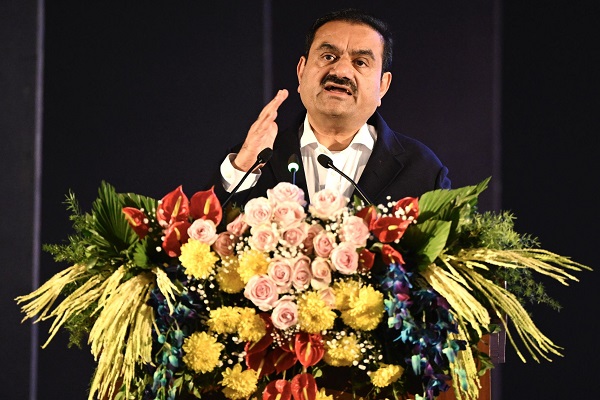Cottoncandy trading range for the day is 52400-52800 - Kedia Advisory

Gold
Gold prices inched up by 0.04% to settle at Rs.88,023, supported by sustained safe-haven demand amid geopolitical tensions and trade uncertainties. The ongoing conflict in the Red Sea, with the U.S. continuing strikes against Yemen’s Houthis, fueled market unease. Additionally, escalating tariff threats between the U.S. and its major trading partners kept investors cautious, further bolstering gold’s appeal. China’s gold market showed resilience, driven by record ETF inflows in February and an improving economic outlook that hints at a recovery in jewelry demand. Notably, the People’s Bank of China extended its gold purchases for a fourth consecutive month, raising total reserves to a record 2,290 tonnes, constituting 5.9% of foreign exchange holdings. This continued buying spree, coupled with a 10-tonne increase in the first two months of 2025, signals sustained central bank confidence in gold. Meanwhile, Indian gold demand remains under pressure. Record-high prices led to discounts widening to $39 an ounce - the highest in eight months - as imports plunged 85% in February to a two-decade low. The World Gold Council (WGC) projects 2025 consumption between 700-800 metric tons, down from last year’s nine-year peak of 802.8 tons. Technically, the market saw short covering, reflected in a 4.42% drop in open interest to 13,779 contracts while prices rose by Rs.32. Gold now finds support at Rs.87,760, with a further downside possible to Rs.87,490. Resistance is observed at Rs.88,230, and a breakout could push prices toward Rs.88,430.
Trading Ideas:
* Gold trading range for the day is 87490-88430.
* Gold steadied as strong safe-haven demand persisted amid trade tariff uncertainty and geopolitical tensions.
* The U.S. reaffirmed its commitment to striking Yemen’s Houthis until they cease attacks on Red Sea shipping, adding to market unease.
* China sees record gold ETF inflows in February, jewelry demand should stabilize as the economy improves – WGC
Silver
Silver prices dipped by 0.2% to settle at Rs.100,536, driven by profit booking after recent gains fueled by rising tariff tensions and increased expectations of Federal Reserve rate cuts following weaker U.S. inflation data. Heightened trade disputes, notably President Trump’s threat of 200% tariffs on European wines in retaliation for the EU’s 50% tariff on American whiskey, added to market volatility. Meanwhile, U.S. retail sales showed a weaker-than-expected rebound in February, suggesting softer economic growth, further supporting the case for rate cuts. Silver inventories at Comex surged to a record high of 403.2 million ounces as of February 27, reflecting stockpiling despite price volatility. On the production side, Hecla Mining reported a significant 13% rise in silver output for 2024, reaching 16.2 million ounces - its second-highest output in over a century. However, global supply is expected to remain tight. Silver demand is projected to stay stable at 1.2 billion ounces in 2025, driven primarily by industrial applications and retail investment, even as jewelry demand, particularly in India, declines by 6% due to high local prices. Industrial silver fabrication is forecast to grow 3%, surpassing 700 million ounces for the first time, supported by green energy initiatives. Technically, the market remains under long liquidation, indicated by a 0.41% drop in open interest to 22,872 contracts, alongside a Rs.202 price decline. Silver finds immediate support at Rs.99,905, with a further downside possible to Rs.99,270. Resistance is now pegged at Rs.100,980, and a breakout above this could push prices toward Rs.101,420.
Trading Ideas:
* Silver trading range for the day is 99270-101420.
* Silver dropped on profit booking after prices rose amid rising tariff tensions.
* U.S. retail sales rebounded by less than expected in February
* Markets expect the U.S. central bank to hold interest rates on Wednesday, with the next cut in June.
Crude Oil
Crude oil prices edged up by 0.43% to settle at Rs.5865, supported by China’s promise of new measures to boost consumption and escalating geopolitical tensions following U.S. airstrikes on Yemen’s Houthis. The U.S. reaffirmed its commitment to ongoing attacks until the group ceases Red Sea shipping assaults, fueling supply concerns. Despite this, Goldman Sachs revised down its crude price forecasts for December 2025 and 2026, citing slower global demand growth and increased OPEC+ output. U.S. crude stocks in the Strategic Petroleum Reserve rose to 395.6 million barrels - the highest since November 2022 - with an additional 275,000 barrels added last week. However, commercial crude inventories increased by only 1.448 million barrels, below the expected 2 million build. Meanwhile, Cushing, Oklahoma, saw a draw of 1.228 million barrels, contrasting the previous week’s 1.124 million-barrel rise. Gasoline stocks plunged by 5.737 million barrels, marking the sharpest drop in five months, while distillate inventories fell by 1.559 million barrels, exceeding the expected 1.3 million draw. The International Energy Agency (IEA) projects a global oil surplus of 600,000 barrels per day in 2025, which could widen by 400,000 bpd if OPEC+ extends output cuts. Technically, crude oil is witnessing fresh buying, with open interest rising 7.18% to 6109 contracts alongside a Rs.25 price increase. Support lies at Rs.5829, with further downside potential to Rs.5792. Resistance is seen at Rs.5912, and a breakout could push prices toward Rs.5958.
Trading Ideas:
* Crudeoil trading range for the day is 5792-5958.
* Crude oil prices rose after China promised new measures, and U.S. ordered attacks on Yemen's Houthis.
* Goldman Sachs has lowered its December 2025 and average 2026 forecasts for Brent and WTI crude oil prices.
* Crude stocks in the U.S. Strategic Petroleum Reserve rose to 395.6 million barrels last week, the highest level since November 2022
Natural Gas
Natural gas prices slipped by -1.51% to settle at Rs.351.4, pressured by record-high output, negative spot prices at the Waha Hub in West Texas, and forecasts predicting mild weather through early April. This reduced heating demand is expected to keep withdrawals from storage lower than typical for this time of year. Despite this, gas stockpiles remain about 12% below normal levels due to heavy withdrawals during the extreme cold in January and February, including record January draws. Production continues to climb, with LSEG reporting average output in the Lower 48 U.S. states reaching 105.9 billion cubic feet per day (bcfd) so far in March, surpassing February’s record of 105.1 bcfd. Weather projections suggest warmer-than-normal temperatures through April 1, which could limit demand. Storage withdrawals for the week ending March 7 totaled 62 billion cubic feet (bcf), exceeding market expectations of 50 bcf, with sharp declines in the East (-33 bcf) and Midwest (-26 bcf). The U.S. Energy Information Administration (EIA) projects record-breaking natural gas production and demand for 2025, with dry gas output expected to hit 104.6 bcfd, rising to 107.3 bcfd in 2026. LNG exports are also forecasted to grow, reaching 14.0 bcfd in 2025 and 16.2 bcfd in 2026, up from 12.0 bcfd in 2024. Technically, the market is under fresh selling pressure, evidenced by an 8.45% rise in open interest to 14,175 contracts while prices fell Rs.5.4. Support is at Rs.345, with further downside to Rs.338.5. Resistance stands at Rs.362.1, and a break above could push prices toward Rs.372.7.
Trading Ideas:
* Naturalgas trading range for the day is 338.5-372.7.
* Natural gas eased on record output, and forecasts for the weather to remain mild through the start of April.
* US LNG export feed gas on track to hit record high in March
* Meteorologists projected weather would remain mostly warmer than normal through April 1.
Copper
Copper prices climbed by 0.72% to settle at Rs.906.25, driven by renewed optimism over China’s latest stimulus measures aimed at boosting household income, spending, and industrial growth. This policy support, coupled with expectations of potential U.S. tariffs on copper imports under President Trump, fueled demand expectations and added upward pressure on prices. Further supporting prices was a notable decline in available inventories within the London Metal Exchange (LME) system, where on-warrant copper stocks dropped to 136,300 tons - the lowest since mid-June - following 11,675 tons of fresh cancellations. With cancelled warrants exceeding 40% of total stocks, more copper is anticipated to exit LME warehouses soon, tightening supply further. However, global fundamentals presented a mixed picture. Copper output from Chile, the top producer, fell 2.1% year-on-year in January to 426,889 metric tons, adding supply pressure. Meanwhile, China’s unwrought copper imports fell 7.2% year-on-year to 837,000 metric tons over the first two months of 2025, reflecting increased domestic smelting capacity reducing reliance on imports. Copper stocks in Shanghai Futures Exchange surged to 268,337 tons by February 28, more than tripling since early January, highlighting ample supply within China despite rising global prices. Technically, the market experienced short covering, with open interest dropping by 2.85% to 5,311 contracts as prices rose Rs.6.45. Copper finds support at Rs.899.6, with a potential retest at Rs.893 if breached. Resistance stands at Rs.909.8, and a breakout above this could push prices toward Rs.913.4.
Trading Ideas:
* Copper trading range for the day is 893-913.4.
* Copper gained as China’s latest stimulus measures boosted demand expectations.
* Further supporting prices were expectations that US President Donald Trump may impose tariffs on copper imports.
* Copper output in Chile, fell 2.1% year-on-year in January to 426,889 metric tons.
Zinc
Zinc prices slipped by 0.52% to settle at Rs.279.2, driven by profit booking after an earlier rally sparked by Nyrstar's announcement of a 25% production cut at its Hobart smelter in Australia from April. The cut, attributed to challenging raw material market conditions, negative treatment charges, and rising costs, initially fueled bullish sentiment. Hobart’s annual production capacity of 260,000 metric tons underscores the potential supply disruption. Adding to the supply squeeze, London Metal Exchange (LME) on-warrant zinc stocks fell to 94,700 tons - their lowest since November 2023 - after 42,575 tons were freshly canceled. Meanwhile, global mined zinc production declined for the third straight year in 2024, aligning with a 7% drop in Chinese refined zinc output. The Red Dog Mine in Alaska, contributing 10% of global supply, is also expected to slow output in 2025 due to ore depletion. This supply crunch led to a global zinc market deficit of 62,000 tons in 2024, reversing a 310,000-ton surplus from 2023, according to ILZSG data. Chinese refined zinc production fell over 4% year-on-year in February 2025, though March output is expected to rebound by over 13% month-on-month due to increased production days and post-maintenance recovery. Technically, the market is under long liquidation, with open interest dropping by 10.81% to 2,179 contracts. Zinc finds support at Rs.278.1, with a potential retest at Rs.277 if breached. Resistance is now seen at Rs.280.8, and a move above could push prices toward Rs.282.4.
Trading Ideas:
* Zinc trading range for the day is 277-282.4.
* Zinc dropped on profit booking after prices rose on Nyrstar cutting production in Australia.
* LME on-warrant stocks fell to 94,700 tons, their lowest since November 2023.
* Zinc inventories in warehouses monitored by the Shanghai Futures Exchange rose 0.9% from last Friday.
Aluminium
Aluminium prices remained flat at Rs.264.55, holding steady despite market volatility, as lower supply from major producers paired with expectations of stronger demand balanced the market. China’s record output of 44 million tons in 2024 signals an impending slowdown, with production curbs enforced by Beijing’s 25 million-ton cap aimed at controlling oversupply and cutting carbon emissions. Adding to supply pressures, China’s removal of export tax rebates shifted local producers’ focus to domestic sales, reducing global exports and supporting international aluminium prices. On the demand side, optimism emerged after the Chinese government announced plans to expand its budget deficit to record levels, funding special bonds to stimulate economic growth - a move likely to boost infrastructure and aluminium consumption. JP Morgan forecasts a significant tightening in the global aluminium market, predicting a deficit exceeding 600,000 tons by 2025, driven by slowing supply growth, particularly in China. Meanwhile, global primary aluminium output rose 2.7% year-on-year to 6.252 million tons in January, according to the International Aluminium Institute (IAI), while China’s production climbed 2.6% to 7.32 million tons during January-February, supported by improved profitability and easing alumina supply constraints. From a technical perspective, the market remains under long liquidation, with open interest falling by 1.86% to 2,802 contracts. Aluminium now finds support at Rs.263.5, with a potential drop to Rs.262.5 if breached. Resistance stands at Rs.265.9, and a breakout above this level could see prices testing Rs.267.3.
Trading Ideas:
* Aluminium trading range for the day is 262.5-267.3.
* Aluminium settled flat amid lower supply expectation
* Aluminium inventories in warehouses monitored by the Shanghai Futures Exchange fell 3% from last Friday.
* Global primary aluminium output in January rose 2.7% year on year to 6.252 million tonnes
Cottoncandy
Cottoncandy prices slipped by -0.49% to Rs.52,610, driven by an uptick in supply and sluggish mill buying as mills remain comfortably stocked, reducing immediate demand. The Cotton Association of India (CAI) further trimmed its 2024-25 crop estimate by 2% to 295.30 lakh bales, citing a lower-than-expected harvest in central India. This marks a significant drop from last season’s 327.45 lakh bales, driven by a 10% decline in cultivation area. Regionally, Gujarat and Maharashtra are set to see declines of 4 lakh and 3 lakh bales respectively, while Odisha may see a minor rise of 0.55 lakh bales. On the import front, CAI expects a sharp rise, forecasting imports to double to 32 lakh bales in 2024-25, up from 15.2 lakh bales last season, with 22 lakh bales already imported by February. Domestic consumption remains steady at 315 lakh bales, with 142 lakh bales consumed by February-end. However, exports are projected to slump by 40% to 17 lakh bales. Closing stocks are forecasted to shrink to 23.49 lakh bales - down from 30.19 lakh bales last year. Globally, Brazil’s cotton output is expected to rise by 1.6% to 3.7616 million tons, supported by a 4.8% expansion in planted area. Meanwhile, U.S. cotton stocks-to-use ratio rose to 39%, with average upland farm prices projected lower at 63.5 cents per pound. Technically, the market is under long liquidation, evidenced by a -9.13% drop in open interest to 219. Support is at Rs.52,500, with further downside possible to Rs.52,400. Resistance stands at Rs.52,700, with a potential breakout to Rs.52,800.
Trading Ideas:
* Cottoncandy trading range for the day is 52400-52800.
* Cotton dropped due to a substantial increase in supply and limited mill buying.
* CAI has further reduced its 2024-25 crop estimate by 2 per cent to 295.30 lakh bales
* The government in its second advance estimates, reduced the cotton crop projection by 1.5 per cent to 294.25 lakh bales
* In Rajkot, a major spot market, the price ended at 25558.1 Rupees dropped by -0.03 percent.
Turmeric
Turmeric surged by 5.55% to close at 12,406, driven by lower yield expectations and concerns over crop health, especially in Nanded, where smaller rhizomes and signs of crop rot are reported. Though the area under turmeric cultivation expanded by 10% to 3.3 lakh hectares this season compared to 3 lakh hectares last year, untimely rains are likely to offset the gains, keeping production either flat or fluctuating within a 3-5% range. This season’s yield may end up similar to last year’s 10.75 lakh tonnes, despite the increased area. New crop arrivals have begun in key mandis like Nizamabad and Hingoli, but supply pressures remain softened by persistent worries about yield quality and slow rhizome growth. The export market also reflects strong demand, with turmeric exports from April to December 2024 rising by 13% to 136,921 tonnes, compared to 121,170 tonnes in the same period last year. December alone saw a 46.94% jump in exports year-on-year. Interestingly, imports also rose by a significant 84.35% over the same period, but December saw a sharp month-on-month drop of 44.66%, suggesting reduced import dependency amid stronger domestic demand. Technically, the market is experiencing short covering, with open interest down 3.38% to 12,135 contracts. Turmeric has immediate support at 12,002, with a further downside target at 11,600 if breached. On the upside, resistance is pegged at 12,632, and a break above this could propel prices toward the 12,860 level, continuing the bullish momentum.
Trading Ideas:
* Turmeric trading range for the day is 11600-12860.
* Turmeric gained as new crop yields are expected to be 10-15% lower this year
* Support also seen amid concerns over slow growth of rhizomes and low yield estimates persist.
* However upside seen limited as arrival of new turmeric crop has started.
* In Nizamabad, a major spot market, the price ended at 12432.35 Rupees gained by 1.56 percent.
Jeera
Jeera prices surged by 2.95%, closing at 21,445, driven by a delayed start to the new crop in Gujarat and Rajasthan due to unfavorable weather conditions. The sowing delay of about a month has kept supply tight, though the upside remains limited due to subdued demand and sufficient existing stock. Farmers are holding around 20 lakh bags of jeera, with only 3-4 lakh bags expected to be traded before the season ends, leaving a significant carry-forward stock of approximately 16 lakh bags. Production for 2023-24 is projected to remain stable at 8.6 lakh tonnes across 11.87 lakh hectares, significantly higher than the previous year's 5.77 lakh tonnes from 9.37 lakh hectares, supported by improved crop conditions and better sowing coverage. India’s competitive pricing is a key driver in the export market, with Indian cumin priced at $3,050 per tonne — about $200 to $250 cheaper than Chinese cumin. This price advantage is expected to attract major buyers like China, reinforcing India’s dominance as the primary global supplier. Jeera exports have shown impressive growth, surging by 70.72% to 165,084.40 tonnes from April to December 2024, compared to 96,701.43 tonnes during the same period last year. Technically, the market remains in fresh buying territory, with open interest rising by 0.1% to 2,862 contracts. Jeera has immediate support at 20,940, with a further downside test at 20,440 if breached. Resistance is now seen at 21,740, and a breakout above this could push prices toward 22,040.
Trading Ideas:
* Jeera trading range for the day is 20440-22040.
* Jeera gains as the start of the new crop of cumin in Gujarat has been delayed by about a month.
* However upside seen limited as demand is low and the current export business is being met from the available stock.
* Jeera exports during Apr-Dec 2024, rose by 70.72 percent at 165,084.40 tonnes as compared to 96,701.43 tonnes exported during Apr- Dec 2023
* In Unjha, a major spot market, the price ended at 21219.1 Rupees dropped by -0.05 percent.
Views express by all participants are for information & academic purpose only. Kindly read disclaimer before referring below views
























